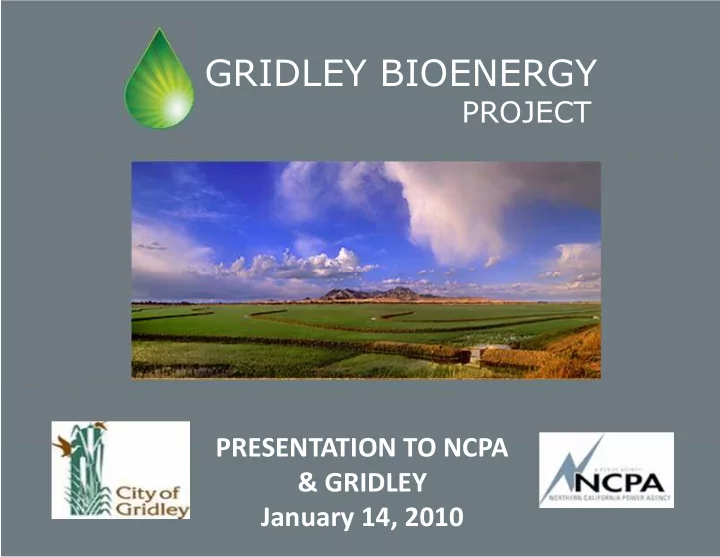

����������������� ������� PRESENTATION TO NCPA & GRIDLEY January 14, 2010 1
Economical Production of Renewable Fuels and Power From Waste Biomass Locally Cost Renewable Produced Competitive 2
Why was Gridley Chosen for this Project and What are the Objectives? � Gridley is an agriculture based town that is representative of hundreds of such towns in the U.S. � The primary agriculture products within 40 miles of Gridley include rice, nuts, alfalfa, olives and a wide variety of fruits and vegetables. The harvesting and processing of these products produces a significant quantity of waste biomass. � Nearly 2.0 million tons of rice straw and rice hulls are generated from rice production annually in this area. The farmers are no longer able to dispose of these materials by burning or in land-fills, thus causing a disposal problem. � Nearby forestlands need to be remediated to remove highly flammable materials that pose a potential significant fire risk. CONFIDENTIAL 3
What Other Locations are Viable for Biomass to Fuels and Electricity? � Several thousand biomass to synthetic diesel fuel and electricity plants (300 dtpd) in the U.S. are possible based on this IBR Technology � Resulting in the production 50 billion gallons of fuel per year and displacing 1.2 billion barrels of imported oil each Year � Creating over 1 million long term jobs CONFIDENTIAL 4
Which Technology was Chosen to Effectively Convert Gridley's Agriculture Waste to Synthetic Diesel Fuel & Electricity? � The potential capability of 12 types of technologies developed by more than 450 organizations was evaluated by REII in cooperation with DOE, NREL and REII’s partners. � A thermochemical approach was determined to have the most potential with respect to technical capability, energy efficiency, economic viability and environmental friendliness. Red Lion Bio-Energy (RLB) and Pacific Renewable Fuel (PRF) were chosen to develop, validate and commercialize this technology. Synthetic Liquid Fuel Production (LFP) Thermochemical Conversion (TCC) Diesel Fuel Catalytic Conversion Pyrolysis + Steam Reforming Agricultural Residues Renewable Electricity CONFIDENTIAL 5
What Organizations are Involved in the Commercial Project and What are Their Roles? Project Sponsors Technology Provider, Project Development and Operations Also representing technology partners. Project development to be done through a project entity (for example, Gridley Bioenergy, LLC) Project Management, DOE Contract Administration Other Partners (+ many others0.) CONFIDENTIAL 6
What Products will the Gridley Plant Produce from Agriculture Waste � Diesel Fuel is a high value Diesel Fuel is a high value product and helps to reduce 300 Dry Tons/Day the cost of renewable Rice Hulls, Rice Straw, power production. power production. Wood and Other Available Waste Materials 5.03 Million Gallons/Year Renewable Synthetic Diesel Fuel 5.98 MWe Renewable Electricity 3.04 MWe Non-Renewable Electricity Up to 4,800 Lbs/Day High Silica Ash CONFIDENTIAL 7
What are the Gridley Bioenergy Commercial Scale Targets? Product ion Costs (EBITA with Debt Included) � 7.5 cents/kWh � $2.85/gallon of synthetic diesel fuel Return on Investment with 25 Year Life � IRR (Internal Rate of Return): 26% � ROI (Return on Investment): 20% Product Yield � 54 gallons of synthetic diesel fuel production per 1.0 dry (ash free) ton of wood Water Use � No net external water required when using biomass feedstock containing ~20 wt% water. Energy Demand � No external natural gas (NG) required (except for plant start-up). � No external electricity required (except for plant start-up). � 46% plant energy efficiency for diesel fuel production (IBEP model results) CONFIDENTIAL 8
What are the Advantages of this Project to Gridley, California’s Rural Communities and the NCPA? � Produce economical renewable fuel and renewable electricity from local agricultural wastes, reducing the need for costly and environmentally harmful disposal. � Provide a local vehicle fuel source for the community, reducing dependence on foreign oil. � Reduce costs for electricity rate payers which will encourage food processing plants to locate in the area. � Create jobs and improve the economy vitality of the region. � Serve as an example to encourage other communities to support similar projects. CONFIDENTIAL 9
DOE / DOA is Supporting the Testing and Validation of Gridley Integrated Biorefinery (IBR) Technology Dec. 4th, 2009 Press Event at the Integrated Biorefinery Site - Left to Right: Dr. Steven Chu, Secretary of Energy; Alex Johnson; Dr. Dennis Schuetzle, REII President; CONFIDENTIAL Congresswoman Marcy Kaptur; Tom Vilsack, Secretary of Agriculture 10
What is the Energy Efficiency of the Gridley Plant Compared to Current Technologies? ��� ������� ���!���!� ��� ��� �� �������������������� ����������������� ������������������ Natural Gas Plant Biomass Combustion Plant PRFC Biorefinery �������������������� �������������������������� (California Average) (California Average) CONFIDENTIAL 11
���������������������������� ��������������� �����!�"�# Gridley DOE Project Timeline: Phase I – Complete Phase II – Additional testing and reporting to be completed during Q1 2011 – Q1 2013 Gridley Bioenergy Commercial Project Timeline: Planning Task 1.1: Develop high-level commercial designs Task 1.2: Determine electricity and fuel production levels Task 1.3: Identify customers for electricity and fuel products Task 1.4: Develop proforma and process guarantees Task 1.5: Obtain project financing CONFIDENTIAL 12
������������������$������������� ��������������� �����!�"�# Permitting, Design, Close of Financing, Site Prep Task 2.1: Select Engineering, Procurement and Construction (EPC) partner Task 2.2: Establish final contract with plant operator Task 2.3: Finalize biomass contracts and off-take agreements Task 2.4: Obtain environmental permits and other approvals Task 2.5: Complete final detailed plant design Task 2.6: Close construction financing Task 2.6: Complete site preparation Procurement, Construction & Check-out Task 3.1: Complete procurement Task 3.2: Assemble plant sub-components Task 3.3: Complete construction Task 3.4: Check-out & Commissioning CONFIDENTIAL 13
��������������$������������ ��������������� �����!�"�# � Create project entity for commercial financing. � Continue muni-bond, private equity, and strategic partner financing discussions targeting close Q1, 2013. � Execute lease agreement for project site with City of Gridley � Complete entitlements before close of financing. � Complete final engineering for the 300 dry ton per day commercial plant before close of financing. � Complete securing of biomass feedstock contracts. � Complete off-take agreements for fuel (through PRFC partners) and power (through Gridley/NCPA). CONFIDENTIAL 14
Recommend
More recommend